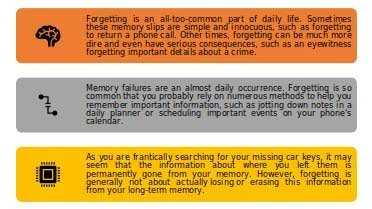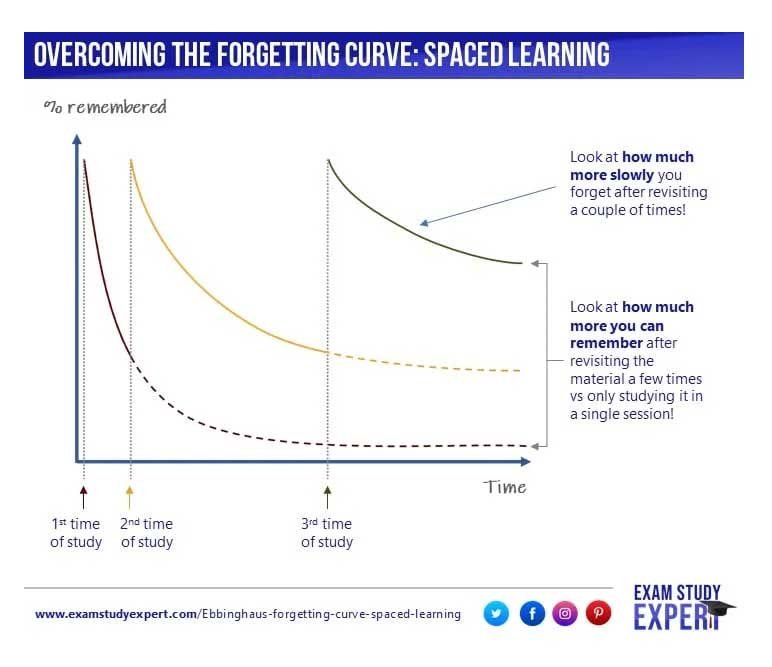
Mayank Joshi
joshimayank@indianoil.in

ABSTRACT — Have you ever cursed yourself of having a bad memory or for not remembering an obvious detail, a name or a song which you know and is at the tip of your tongue, but you cannot recall it. Is good memory the only reason of remembering. Is there a way to memorize and learn better? This article talks about forgetting, the forgetting curve and the best ways of learning and remembering.
Forgetting
Forgetting is the loss or change in information that was previously stored in short-term or long-term memory. It can occur suddenly, or it can occur gradually as old memories are lost. While it is usually normal, excessive, or unusual forgetting might be a sign of a more serious problem.
Why do we Forget?

Schacter’s Seven Sins of Memory
Daniel Schacter, former chair of Harvard University’s Psychology Department and a leading memory researcher.
Sin | Type | Description | Example |
Transience | Forgetting | Accessibility of memory decreases over time | Forget events that occurred long ago |
Absentmindedness | Forgetting | Forgetting caused by lapses in attention | Forget where your phone is |
Blocking | Forgetting | Accessibility of information is temporarily blocked | Tip of the tongue |
Misattribution | Distortion | Source of memory is confused | Recalling a dream memory as a waking memory |
Suggestibility | Distortion | False memories | Result from leading questions |
Bias | Distortion | Memories distorted by current belief system | Align memories to current beliefs |
Persistence | Intrusion | Inability to forget undesirable memories | Traumatic events |
Hermann Ebbinghaus & the Forgetting Curve
From 1880 to 1885, Hermann Ebbinghaus, a German psychologist ran a limited, study on himself and published his hypothesis translated in English as Memory: A Contribution to Experimental Psychology.
Ebbinghaus studied the memorisation of nonsense syllables, by repeatedly testing himself after various time periods and recording the results.
He plotted these results on a graph creating what is now known as the “forgetting curve”.
Ebbinghaus investigated the rate of forgetting, but not the effect of spaced repetition on the increase in retrievability of memories.

Key Learnings from the Ebbinghaus findings

Best ways of Learning
Spaced Learning
This method involves reviewing the material during various timed sessions while making sure to take timed breaks in between. By spacing the review sessions out over time, learners get the chance to revisit the material regularly, increasing their chances of retaining it.
Spaced learning helps learners manage what learned information is retained, enabling them to reshape the forgetting curve. In turn, spaced learning benefits organizations as it supports the retention of skills and increased productivity in the long-term.

Retrieval practice
Write what you know from memory on a blank sheet: a plain sheet of paper is a very under-rated study tool! Put your books away, then scribble down everything you can remember about a topic. After you’ve squeezed out as much as you can from memory, you might like to go back and add in any missing details in a different coloured pen. Next time you train yourself on this topic, aim to have fewer missing details – until you have none at all come the week before the exam!
Draw concept maps from memory: a slightly more sophisticated variant on the “blank sheet” method is drawing concept maps based on what you know of a topic. A concept map links ideas together visually, putting ideas in boxes, and linking them together with arrows to show how they relate.
Make it Accessible
If you want your training content to stick, making access to courses convenient for your learners is crucial. They should have the ability to complete training wherever they are, at any time of the day.
This is where mobile learning, or m-Learning, comes into play. Ensuring your LMS is mobile responsive makes learning and retaining information easier for your learners. They’ll have a much better chance of recollecting and refreshing their knowledge if they can access their courses when and where they like; on the bus to work, or while waiting on a client for a lunch meeting.
Make it Relevant
The human brain is selective and has a limited capacity. When it comes to deciding whether to store pieces of information permanently, the brain can be quite choosy. And this naturally accelerates the forgetting curve. That’s why, when planning training, you should make it as relevant to the learner as possible. The more relevant the training, the easier it will be for them to absorb and remember the information they need.

References
1. Wikipedia
2. https://www.learnupon.com/blog/ebbinghaus-forgetting-curve/
3. https://examstudyexpert.com/memorisation-techniques-for-exams/
4. https://www.health.harvard.edu/healthbeat/foods-linked-to-better-brainpower
Posted in Talent Management | No Comments »
Recent Articles
- Role of Leaders in Team Network Interpersonal Skills
- Unlocking the Tapestry of Learning & Development: a Journey through Time & Networks
- Aarohi – As The Flight Leaves The Land
- 20% Time – Innovation through playfulness
- Workplace Culture of Playfulness: Creating an environment of humour and positivity
- We Aren’t Paying Enough Attention to Humor in the Workplace
- Three quotients to manage talent
- Seriously, What’s so Funny?
- Happy Souls at Work: Playfulness Well-being Productivity
- The Joy of Work: Building a Culture Where Playfulness Meets Performance
- Corporate Learnings from ‘Mogambo’ – The Iconic Villain of Indian Film Mr. India
- Talent Development and Succession Planning for Organizational Sustainability
- An Ideal Workplace – Happy & Fun!
- The role of leadership in encouraging a playful environment
- Injecting Joy into Work: The Benefits of a Playful Office Culture
- Five on Five: Five Leadership Styles for Five Generations ACT & LEAD!
- The CEO’s Dharma: Leadership Lessons from Narada’s Inquiry
- 3-D Leader: BANI and Heart Economy
- The Talent Management Odyssey: A Quest for the Holy Grail of HR
- Generation Z in the Workforce: Challenges and Opportunities
- Talent Management in Post-Independent Indian Governance- A Case Study
- Pareto Principle in the Workplace
- Breaking Good: Sabbatical leave- A comprehensive insight
- Prosocial Emotions as Lever for Employee Engagement
- The Table with the lady
- Can Compassion and Executive Presence Co-exist
- Empathetic Organisations are not Built Overnight !
- Employee Excitement
- Women, Leadership and opportunities
- Corporate Diversity & Inclusion
- Connections in the time of Covid
- Developing connect with the missing shift employee
- Becoming the employer of choice in the new normal
- Open Secret to Build a Culture of Sustainability through GHRM (Green Human Resources Management)
- Green HRM: Building a Culture of Sustainability
- Cultural Lens
- Trust Credibility
- Organizational Culture and Covid-19: An employee’s perspective
- Culture: Fostering Values for Unleashing Human Potential
- Psychological safety in a team: Whose responsibility?
- “Dispelling the fear of failure – Nurturing innovation and experimentation”
- Fighting Fear through Growth Mindset & Experimentation
- Situational Leadership: A Brahmastra
- ONGC Succession Planning
- Leadership
- Unleashing the Power of failure and Innovation: A Call to Action for Indians in the 21st Century
- Managing Executive Obsolescence for Career Growth
- Action Learning
- The Best Coach to Rewire people
- The eLearning series: A practitioner’s take
- Learning in the Flow of Work – Lets step up the Game
- E-learning a practitioner’s take- Part 2
- The Forgetting Curve – The best ways of Memorising & Learning
- Leaders as teachers
- The New India – Post Covid
- Learning & Development Gamified
- About Fear, loneliness and Exile at Workplace
- My Journey as a Coach-Leader
- Lessons from Ramayana
- Delivering Happiness through CSR
- Story of positive transformation
- Conquering the fear of failure
- Role of organization culture and values in growth of human potential
- The cost of Failure is…Learning!
- Talent Experience
- CSR Initiatives: The Key Drivers for India’s Sustainable Development Growth
- Gaining Wisdom from the Mahabharata
- Six Thinking Hats – A Decision Making Technique
- Next Normal of Talent Acquisition
- Talent Experience
- Role of Spirituality in effective Human Resource Management
- The ‘next normal’ workplace – A generational perspective
- The Pursuit for Recognition
- How to make Innovation an integral culture of an Organization
- Nuturing Talent – For Organisational Growth
- How Google Sold Its Engineers on Management
- Talent Leadership: Perhaps the new Talent Management
- Words have Power
- The Ultimate Team Game!
- The ‘Feedback Fridays’
- Talent Experience
- Pursuit of Dominance
- How Does Anticipated Emotion from a Decision Outcome Determine Our Ethical Behaviour? A Working Paper
- Talent Management
- From failing to innovating: Role of HR in promoting experimentation
- Unleashing the Power of Talent Management: Lessons from History to Modern Day
- Embracing Evolution: Behavior-Based Hiring and Technological Synergy for Organization’s Future Workforce
- Transforming Workforce Recruitment
- Data-Driven Play: Leveraging Analytics in Gamified Hiring
- Rational Recipe To Recruitment: Future Of Hiring
- Redefining the hiring recipe: Recruiting candidates beyond the resume!
- The Power of Attitude: Why Employers Seek the Right Mindset
- Principles of Recruitment
